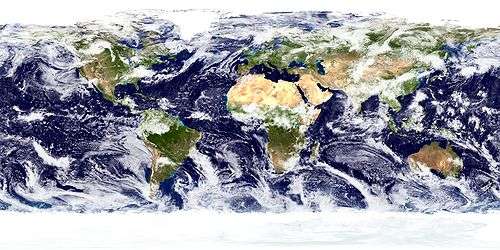East European Plain
The East European Plain (also called the Russian Plain,[1] predominantly by Russian scientists,[2] or historically the Sarmatic Plain)[3] is a vast interior plain extending east of the North European Plain,[4] and comprising several plateaus stretching roughly from 25 degrees longitude eastward. It includes the westernmost Volhynian-Podolian Upland, than the Central Russian Upland, and on the eastern border, encompassing the Volga Upland. The plain includes also a series of major river basins such as the Dnepr Basin, the Oka-Don Lowland, and the Volga Basin. Along the southernmost point of the East European Plain are the Caucasus and Crimean mountain ranges.[4] Together with the North European Plain covering much of central Poland, Estonia, Latvia and Lithuania, it constitutes the European Plain, the mountain-free part of the European landscape.[5]

.png)
The East European Plain covers all or most of the Baltic states,[1] Belarus, Ukraine, Moldova, Romania, and the European portion of Russia. The plain spans approximately 4,000,000 km2 (2,000,000 sq mi) and averages about 170 m (560 ft) in elevation. The highest point of the plain, located in the Valdai Hills is 346.9 metres (1,138.1 ft).
Boundaries
- West: Baltic Sea, Oder and Lusatian Neisse, Sudetenland, Carpathians (Outer Western Carpathians, Outer Eastern Carpathians, Southern Carpathians, Serbian Carpathians).
- South: Balkan Mountains, Crimean Mountains, Caucasus. Black Sea, Sea of Azov and The Caspian Sea, Ustyurt Plateau.
- East: Ural Mountains and Turan Depression.
- North: White Sea, Barents Sea, Kara Sea, Scandinavian Mountains.
Regional subdivisions
- Romania / Moldova
- Moldavian Plateau (Romania, Moldova, Ukraine)
- Wallachian Plain
- Estonia [1]
- Latvia [1]
- Lithuania [1]
- Belarus
- Belarusian Ridge
- Polesia (Belarus, Ukraine)
- Ukraine
- Poland [1]
- Kazakhstan (European part)
- Russia (European part)
- Timan Ridge
- Northern Ridge (Uvaly)
- Mari Depression
- Valdai Hills
- Smolensk–Moscow Upland (Russia, Belarus)
- Central Russian Upland (Russia, Ukraine)
- Oka-Don Lowland
- Volga Upland
- Obshchy Syrt
- Caspian Depression
Other major landforms
The following major landform features are within the East European Plain (listed generally from north to south).
- North Russian Lowlands
- Baltic Uplands
- Belarusian Ridge
- Kuma–Manych Depression
- Bugulma-Belebey Upland
- Vyatskie Uvaly
Largest rivers
- Volga River
- Danube
- Ural River
- Vistula
- Dnieper River
- Don River (Russia)
- Pechora River
- Kama River
- Oka River
- Belaya River
- Daugava
- Rhine
- Neman River
- Pregolya River
See also
- West Siberian Plain, the other major plain of Russia
- Explorers of Siberia
References
- 1 2 3 4 5 6 7 European Plain at Encyclopædia Britannica "Extending from eastern Poland to the Urals, the East European Plain encompasses all of the Baltic states and Belarus, nearly all of Ukraine, and much of the European portion of Russia and reaches north into Finland." — Britannica.
- ↑ Vladimir Klimenko; Olga Solomina, Moscow (2009). "Introduction: Climate of the East European Plain". The Polish Climate in the European Context: An Historical Overview. Springer. p. 71. ISBN 9048131677. Retrieved 17 May 2014.
From introductory Notes to article: V. Klimenko, Moscow Power Engineering Institute, Moscow, Russian Federation; Moscow, Russia; & O. Solomina, Institute of Geography Russian Academy of Sciences, Moscow, Russia.
- ↑ Podwysocki, Melvin H.; Earle, Janet L., eds. (1979). Proceedings of the Second International Conference on Basement Tectonics. Basement Tectonics Committee. p. 379.
- 1 2 John F. Hoffecker (2002). Desolate Landscapes: Ice-Age Settlement in Eastern Europe. Rutgers University Press. pp. 15–21. ISBN 0813529921. Retrieved 17 May 2014.
- ↑ Marshall Cavendish (2010). World and Its Peoples. Volume 8 of Estonia, Latvia, Lithuania, and Poland. p. 1014. ISBN 0761478965. Retrieved 17 May 2014.
External links
![]() Media related to East European Plain at Wikimedia Commons
Media related to East European Plain at Wikimedia Commons
- East European Plain at Ukrainian Soviet Encyclopedia
- East European Plain at Great Soviet Encyclopedia
